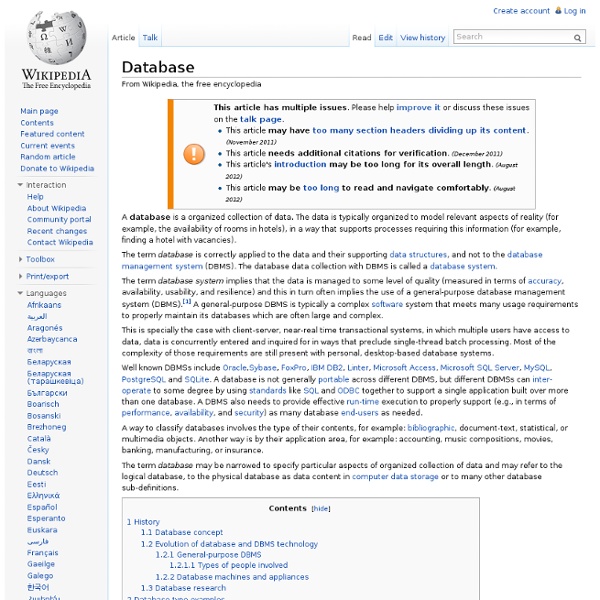Database management system

Object model
In computing, object model has two related but distinct meanings: An object model consists of the following important features: Object Reference Objects can be accessed via object references. Interfaces An interface provides a definition of the signature of a set of methods without specifying their implementation. Actions An action in object-oriented programming (OOP) is initiated by an object invoking a method in another object. Exceptions Programs can encounter various errors and unexpected conditions of varying seriousness. See also[edit] Literature[edit] Weisfeld, Matt (2003). External links[edit]
DBMS definition of DBMS in the Free Online Encyclopedia.
System for quick search and retrieval of information from a database. The DBMS determines how data are stored and retrieved. It must address problems such as security, accuracy, consistency among different records, response time, and memory requirements. These issues are most significant for database systems on computer networks. For more information on database management system (DBMS), visit Britannica.com. (DataBase Management System) Software that controls the organization, storage, retrieval, security and integrity of data in a database. DBMSs may work with traditional programming languages (COBOL, C, etc.) or they may include their own programming language for application development. DBMSs let information systems be changed more easily as the organization's requirements change. Major Features of a DBMS Data Security The DBMS can prevent unauthorized users from viewing or updating the database. This is a common misconception about using a desktop computer DBMS. Database Design
5 of the Best Relational Database Management System for Linux
A Database Management System (DBMS) is described as a set of computer programs that manages the creation, maintenance, and administration of a database. It is a system software package that supports the use of unified collection of data records and files known as databases. A DBMS could utilize any of a variety of database models, such as the network model or relational model. A relational database management system (RDBMS) is a DBMS in which data is stored in the form of tables, and the relationship among the data is stored in the form of tables as well. For those of you who are interested, I have here a list of some of the best Relational Database Management System (RDBMS) for Linux (in no particular order): MySQL MySQL is a central component of the widely used LAMP (Linux, Apache, MySQL, Perl/PHP/Python) web application software stack. Apache Derby Apache Derby is an open source relational database management system (RDBMS) that is based on Java, JDBC, and SQL standards. PostgreSQL
Related:
Related:




-------------------------------------------------------------------------------------------------------------------------------------------------------------------
2025-08-03 18:28
by raviii Aug 4
database: A computer system intended to store large amounts of information reliably and in an organized fashion. Most databases provide users with convenient access to the data, along with helpful search capabilities.
Found in: Hurwitz, J., Nugent, A., Halper, F. & Kaufman, M. (2013) Big Data For Dummies. Hoboken, New Jersey, United States of America: For Dummies. ISBN: 9781118504222. by raviii Jan 1